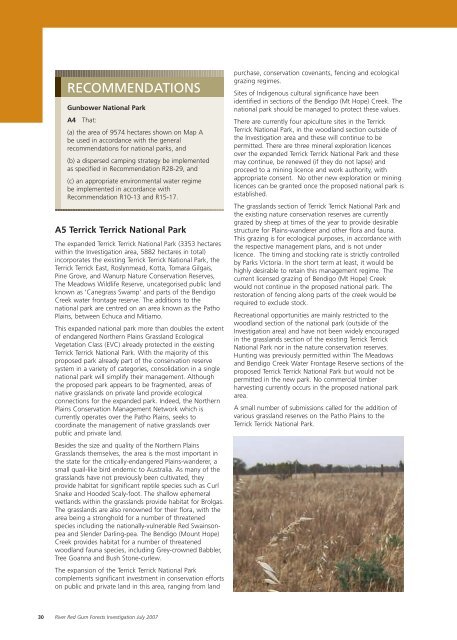Draft Proposals Paper - Full - Victorian Environmental Assessment ...
Draft Proposals Paper - Full - Victorian Environmental Assessment ...
Draft Proposals Paper - Full - Victorian Environmental Assessment ...
You also want an ePaper? Increase the reach of your titles
YUMPU automatically turns print PDFs into web optimized ePapers that Google loves.
RECOMMENDATIONS<br />
Gunbower National Park<br />
A4<br />
That:<br />
(a) the area of 9574 hectares shown on Map A<br />
be used in accordance with the general<br />
recommendations for national parks, and<br />
(b) a dispersed camping strategy be implemented<br />
as specified in Recommendation R28-29, and<br />
(c) an appropriate environmental water regime<br />
be implemented in accordance with<br />
Recommendation R10-13 and R15-17.<br />
A5 Terrick Terrick National Park<br />
The expanded Terrick Terrick National Park (3353 hectares<br />
within the Investigation area, 5882 hectares in total)<br />
incorporates the existing Terrick Terrick National Park, the<br />
Terrick Terrick East, Roslynmead, Kotta, Tomara Gilgais,<br />
Pine Grove, and Wanurp Nature Conservation Reserves,<br />
The Meadows Wildlife Reserve, uncategorised public land<br />
known as ‘Canegrass Swamp’ and parts of the Bendigo<br />
Creek water frontage reserve. The additions to the<br />
national park are centred on an area known as the Patho<br />
Plains, between Echuca and Mitiamo.<br />
This expanded national park more than doubles the extent<br />
of endangered Northern Plains Grassland Ecological<br />
Vegetation Class (EVC) already protected in the existing<br />
Terrick Terrick National Park. With the majority of this<br />
proposed park already part of the conservation reserve<br />
system in a variety of categories, consolidation in a single<br />
national park will simplify their management. Although<br />
the proposed park appears to be fragmented, areas of<br />
native grasslands on private land provide ecological<br />
connections for the expanded park. Indeed, the Northern<br />
Plains Conservation Management Network which is<br />
currently operates over the Patho Plains, seeks to<br />
coordinate the management of native grasslands over<br />
public and private land.<br />
Besides the size and quality of the Northern Plains<br />
Grasslands themselves, the area is the most important in<br />
the state for the critically-endangered Plains-wanderer, a<br />
small quail-like bird endemic to Australia. As many of the<br />
grasslands have not previously been cultivated, they<br />
provide habitat for significant reptile species such as Curl<br />
Snake and Hooded Scaly-foot. The shallow ephemeral<br />
wetlands within the grasslands provide habitat for Brolgas.<br />
The grasslands are also renowned for their flora, with the<br />
area being a stronghold for a number of threatened<br />
species including the nationally-vulnerable Red Swainsonpea<br />
and Slender Darling-pea. The Bendigo (Mount Hope)<br />
Creek provides habitat for a number of threatened<br />
woodland fauna species, including Grey-crowned Babbler,<br />
Tree Goanna and Bush Stone-curlew.<br />
The expansion of the Terrick Terrick National Park<br />
complements significant investment in conservation efforts<br />
on public and private land in this area, ranging from land<br />
purchase, conservation covenants, fencing and ecological<br />
grazing regimes.<br />
Sites of Indigenous cultural significance have been<br />
identified in sections of the Bendigo (Mt Hope) Creek. The<br />
national park should be managed to protect these values.<br />
There are currently four apiculture sites in the Terrick<br />
Terrick National Park, in the woodland section outside of<br />
the Investigation area and these will continue to be<br />
permitted. There are three mineral exploration licences<br />
over the expanded Terrick Terrick National Park and these<br />
may continue, be renewed (if they do not lapse) and<br />
proceed to a mining licence and work authority, with<br />
appropriate consent. No other new exploration or mining<br />
licences can be granted once the proposed national park is<br />
established.<br />
The grasslands section of Terrick Terrick National Park and<br />
the existing nature conservation reserves are currently<br />
grazed by sheep at times of the year to provide desirable<br />
structure for Plains-wanderer and other flora and fauna.<br />
This grazing is for ecological purposes, in accordance with<br />
the respective management plans, and is not under<br />
licence. The timing and stocking rate is strictly controlled<br />
by Parks Victoria. In the short term at least, it would be<br />
highly desirable to retain this management regime. The<br />
current licensed grazing of Bendigo (Mt Hope) Creek<br />
would not continue in the proposed national park. The<br />
restoration of fencing along parts of the creek would be<br />
required to exclude stock.<br />
Recreational opportunities are mainly restricted to the<br />
woodland section of the national park (outside of the<br />
Investigation area) and have not been widely encouraged<br />
in the grasslands section of the existing Terrick Terrick<br />
National Park nor in the nature conservation reserves.<br />
Hunting was previously permitted within The Meadows<br />
and Bendigo Creek Water Frontage Reserve sections of the<br />
proposed Terrick Terrick National Park but would not be<br />
permitted in the new park. No commercial timber<br />
harvesting currently occurs in the proposed national park<br />
area.<br />
A small number of submissions called for the addition of<br />
various grassland reserves on the Patho Plains to the<br />
Terrick Terrick National Park.<br />
30 River Red Gum Forests Investigation July 2007
















